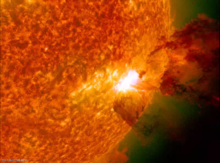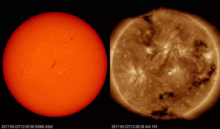news
Submitted on 2018-08-13
On 12 August, the Parker Solar Probe (PSP) was launched from Cape Canaveral, Florida. Its main science goals are to trace the flow of energy and understand the heating of the solar corona and to explore what accelerates the solar wind.
Submitted on 2018-08-07
In preparation for the Open Door days at the Space Pole on 29 and 30 September, a movie has been created with some of the most spectacular solar eruptions that occurred during solar cycle 24.
Submitted on 2018-08-01
An international team of scientists has found the first evidence of a source of high-energy cosmic neutrinos, pointing to a long-sought cosmic ray accelerator. Meanwhile, neutron counts from cosmic rays are on the rise again.
Submitted on 2018-07-24
A small sunspot observed on 21 July may end the currently longest interval without sunspots observed so far during this solar cycle transition.
Submitted on 2018-07-16
Some sunspots tried to develop in a relatively large faculae field.
Submitted on 2018-07-10
Some of last week's observed coronal mass ejections (CMEs) had an interesting story to tell.
Submitted on 2018-07-04
The Royal Observatory of Greenwich has installed four new state-of-the-art telescopes (AMAT), destined for both researchers and the broad public.
Submitted on 2018-06-19
A compilation of the most memorable space weather moments of 2017, featuring data, links and movies.
Submitted on 2018-06-06
Scientists from the STCE have contributed to a research programme that has detected -for the first time- proton aurora on Mars. They used data gathered during the period 2004-2011 by the SPICAM ultraviolet spectrometer on board of ESA's Mars Express.
Submitted on 2018-05-29
Sunspot region NOAA 2172 announced itself with dynamic coronal loops towering over the solar limb, and has produced already 2 C-class flares.
Pages
Zircon - This is a contributing Drupal Theme
Design by
WeebPal.



























































